EM Algorithm in the Slash 2S-Lindley Distribution with Applications
Abstract
1. Introduction
2. Density and Properties
2.1. Stochastic Representation
2.2. Properties
2.3. Moments
3. Inference
3.1. Moments Estimators
3.2. ML Estimators
3.3. EM Algorithm
- Step M1: update as,
- Step M2: update as the solution of the following non-linear equation
3.4. Simulation Study
| Algorithm 1 For simulating values from the distribution |
|
4. Applications
4.1. Application 1: Patients with Acute Bone Cancer
4.2. Application 2: Air Transceiver Repair Times
5. Conclusions
- The S2SL distribution has two different stochastic representations, given in Equation (2) and Proposition 5.
- The expressions of the pdf, cdf, and hazard function are obtained, all of which have a closed form and are represented by the lower incomplete gamma function.
- When the coefficients of asymmetry and kurtosis are analysed, the S2SL model is shown to be more flexible than the 2SL model. Furthermore, as shown in Table 1, the distribution tails become heavier as parameter q diminishes.
- Implementation of the EM algorithm allows ML estimators for the model parameters to be obtained more efficiently.
- The simulation study shows that as the sample size is increased, the ML estimators draw progressively closer to the true values of the parameters, suggesting that the estimators are consistent and stable.
- In the applications to real data, the S2LS distribution is seen to provide a better fit to the data when compared with the 2SL and LSD distributions, reflected in lower values in the AIC and BIC criteria.
Author Contributions
Funding
Data Availability Statement
Conflicts of Interest
Appendix A
- Density functionrm(list=ls(all=TRUE))x <- seq(0.04,15,0.006)library(expint)pdf_S2SL <- function(x,beta,q){G4 <- gamma(q+4)-gammainc(q+4,beta*x)G3 <- gamma(q+3)-gammainc(q+3,beta*x)G2 <- gamma(q+2)-gammainc(q+2,beta*x)((q*x^(-(q+1)))/(6*beta^q*(1+beta)^2))*(G4+6*beta*G3+6*beta^2*G2)}resultado1 <- pdf_S2SL(x,1,1)resultado2 <- pdf_S2SL(x,1,3)resultado3 <- pdf_S2SL(x,1,5)plot(x,resultado1,type="l",lty=1,lwd=2,xlab="x",ylab="Density",xlim=c(0,13),ylim=c(0,0.25),cex.lab=1.35,cex.axis=1.35)lines(x,resultado2,lty=2,lwd=2)lines(x,resultado3,lty=3,lwd=2)
- Hazard functionhazard_S2SL <- function(x, beta, q) {library(expint)x <- seq(0.04, 15, 0.006)G44 <- gamma(q+4)-gammainc(beta*x,q+4)G33 <- gamma(q+3)-gammainc(beta*x,q+3)G22 <- gamma(q+2)-gammainc(beta*x,q+2)G4 <- gamma(4)-gammainc(beta*x,4)G3 <- gamma(3)-gammainc(beta*x,3)G2 <- gamma(2)-gammainc(beta*x,2)numerator <- q*x^(-(q+1))*(G44+6*beta*(G33+beta*G22))denominator <- 6*beta^(q)*(1+beta)^2-x^(-q)*((beta*x)^q*(G4+6*beta*(beta*G2+G3))-6*beta*(beta*G22+G33)-G44)hazard <- numerator/denominatorreturn(hazard)}
- Asymmetry and kurtosis coefficientrm(list=ls(all=TRUE))library(plot3D)library(latex2exp)beta <- seq(3.1,15,length=40)q <- seq(3.1,15,length=40)beta2 <- seq(4.1,15,length=40)q2 <- seq(4.1,15,length=40)Skewness_S2SL <- function(beta,q){m1 <- (2*q*(beta+2))/(beta*(q-1)*(1+beta))m2 <- (2*q*(3*beta^2+12*beta+10))/(beta^2*(q-2)*(1+beta)^2)m3 <- (24*q*(beta^2+5*beta+5))/(beta^3*(q-3)*(1+beta)^2)(m3-3*m1*m2+2*m1^3)/((m2-m1^2)^(3/2))}Kurtosis_S2SL <- function(beta2,q2){m1 <- (2*q2*(beta2+2))/(beta2*(q2-1)*(1+beta2))m2 <- (2*q2*(3*beta2^2+12*beta2+10))/(beta2^2*(q2-2)*(1+beta2)^2)m3 <- (24*q2*(beta2^2+5*beta2+5))/(beta2^3*(q2-3)*(1+beta2)^2)m4 <- (120*q2*(beta2^2+6*beta2+7))/(beta2^4*(q2-4)*(1+beta2)^2)(m4-4*m1*m3+6*m1^2*m2-3*m1^4)/((m2-m1^2)^2)}Resultado_Skewness <- outer(beta,q,Vectorize(Skewness_S2SL))Resultado_Kurtosis <- outer(beta2,q2,Vectorize(Kurtosis_S2SL))persp(beta,q,Resultado_Skewness,theta=55,phi=20,col="#CAFF70",xlab=TeX(’$\\beta$’),ylab=TeX(’$q$’),zlab="Skewness",ticktype="detailed",nticks=4,shade=0.3,cex.lab=1.2,cex.axis=1.2,cex.main=1.2,cex.sub=1.2)persp(beta2,q2,Resultado_Kurtosis,theta=55,phi=20,col="#FFD700",xlab=TeX(’$\\beta$’),ylab=TeX(’$q$’),zlab="Kurtosis",ticktype="detailed",nticks=4,shade=0.3,cex.lab=1.2,cex.axis=1.2,cex.main=1.2,cex.sub=1.2)
- Simulation study for the S2SL distributionrm(list=ls(all=TRUE))library(knitr)library(pracma)set.seed(1234)replicas=1000b_true=4q_true=0.5muestra<-c(50,100,200,500)resultados<-list()for(J in muestra){cat("Processing sample size:",J,"\n")flush.console()bias.rep<-c()se.rep<-c()CP.rep<-c()est.rep<-c()for(j in 1:replicas){if(j%%100==0){cat("Replica:",j,"for sample size:",J,"\n")flush.console()}Z1<-rbinom(J,1,1/(1+b_true))Z2<-rbinom(J,1,1/(1+b_true))U<-rbeta(J,q_true,1)shape_Y<-2+Z1+Z2rate_Y<-b_true*Ux<-rgamma(J,shape=shape_Y,rate=rate_Y)beta_last=1q_last=1dif=1max.iter=10000i<-1n<-length(x)while(i<=max.iter&dif>0.0001){u<-numeric(n)k<-numeric(n)for(j in 1:n){g2<-gamma(2+q_last)g3<-gamma(3+q_last)g4<-gamma(4+q_last)G2<-pgamma(x[j]*beta_last,q_last+2)G3<-pgamma(x[j]*beta_last,q_last+3)G4<-pgamma(x[j]*beta_last,q_last+4)G5<-pgamma(x[j]*beta_last,q_last+5)Sumf<-g2*G2+(g3*G3)/beta_last+((g4*G4)/(6*(beta_last)^2))u[j]<-(1/(x[j]*beta_last*Sumf))*(g2*G3*(2+q_last)+((g3*(3+q_last)*G4)/beta_last)+((g4*(4+q_last)*G5)/(6*beta_last^2)))int1<-integrate(function(w) log(w)*w^(q_last+1)*exp(-w),0,x[j]*beta_last)$valueint2<-integrate(function(w) log(w)*w^(q_last+2)*exp(-w),0,x[j]*beta_last)$valueint3<-integrate(function(w) log(w)*w^(q_last+3)*exp(-w),0,x[j]*beta_last)$valuek[j]<--log(x[j]*beta_last)+int1/Sumf+int2/(beta_last*Sumf)+int3/(6*((beta_last)^2)*Sumf)}q_new<--n/sum(k)solve_beta<-function(beta_val){(4*n/beta_val)-(2*n)/(1+beta_val)-sum(x*u)}result<-uniroot(solve_beta,interval=c(0.01,100))beta_new<-result$rootdif<-max(abs(c(beta_new,q_new)-c(beta_last,q_last)))beta_last<-beta_newq_last<-q_newi<-i+1}param<-cbind(beta_last,q_last)loglike<-function(theta,x,t.param=TRUE){beta=theta[1]q=theta[2]if(t.param){beta=exp(theta[1]);q=exp(theta[2])}ll=log(q)-(q+1)*log(x)-log(6)-q*log(beta)-2*log1p(beta)+log(exp(pgamma(beta*x,shape=q+4,log.p=TRUE)+lgamma(q+4))+6*beta*(exp(pgamma(beta*x,shape=q+3,log.p=TRUE)+lgamma(q+3))+beta*exp(pgamma(beta*x,shape=q+2,log.p=TRUE)+lgamma(q+2))))-sum(ll)}H<-hessian(loglike,x0=param,x=x,t.param=FALSE)var.est<-diag(solve(H))if(min(var.est)>0){bias.rep<-rbind(bias.rep,param-c(b_true,q_true))se.rep<-rbind(se.rep,sqrt(var.est))est.rep<-rbind(est.rep,param)lim.inf<-param-1.96*sqrt(var.est)lim.sup<-param+1.96*sqrt(var.est)cp.aux<-as.numeric(c(b_true,q_true)>lim.inf&c(b_true,q_true)<lim.sup)CP.rep<-rbind(CP.rep,cp.aux)}}est_mean<-round(apply(est.rep,2,mean),3)se_prom<-round(apply(se.rep,2,mean),3)rmse<-round(sqrt(apply(bias.rep^2,2,mean)),3)cp_prom<-round(apply(CP.rep,2,mean),3)resultados[[as.character(J)]]<-cbind(est_mean,se_prom,rmse,cp_prom)}tabla_resultados<-as.matrix(do.call(cbind,resultados))tabla_latex<-kable(tabla_resultados,format="latex",booktabs=TRUE,digits=3)print(tabla_latex)
References
- Jonhson, N.L.; Kotz, S.; Balakrishnan, N. Continuous Univariate Distributions, 2nd ed.; Wiley: New York, NY, USA, 1995; Volume 1. [Google Scholar]
- Rogers, W.H.; Tukey, J.W. Understanding some long-tailed symmetrical distributions. Stat. Neerl. 1972, 26, 211–226. [Google Scholar] [CrossRef]
- Mosteller, F.; Tukey, J.W. Data Analysis and Regression; Addison-Wesley: Reading, MA, USA, 1977. [Google Scholar]
- Kafadar, K. A biweight approach to the one-sample problem. J. Am. Statist. Assoc. 1982, 77, 416–424. [Google Scholar] [CrossRef]
- Wang, J.; Genton, M.G. The multivariate skew-slash distribution. J. Stat. Plan. Inference 2006, 136, 209–220. [Google Scholar] [CrossRef]
- Gómez, H.W.; Quintana, F.A.; Torres, F.J. A New Family of Slash-Distributions with Elliptical Contours. Stat. Probab. Lett. 2007, 77, 717–725, Erratum in Erratum in Stat. Probab. Lett. 2008, 78, 2273–2274. [Google Scholar] [CrossRef]
- Olmos, N.M.; Varela, H.; Gómez, H.W.; Bolfarine, H. An extension of the half-normal distribution. Stat. Pap. 2012, 53, 875–886. [Google Scholar] [CrossRef]
- Olmos, N.M.; Varela, H.; Bolfarine, H.; Gómez, H.W. An extension of the generalized half-normal distribution. Stat. Pap. 2014, 55, 967–981. [Google Scholar] [CrossRef]
- Astorga, J.M.; Reyes, J.; Santoro, K.I.; Venegas, O.; Gómez, H.W. A Reliability Model Based on the Incomplete Generalized Integro-Exponential Function. Mathematics 2020, 8, 1537. [Google Scholar] [CrossRef]
- Rivera, P.A.; Barranco-Chamorro, I.; Gallardo, D.I.; Gómez, H.W. Scale Mixture of Rayleigh Distribution. Mathematics 2020, 8, 1842. [Google Scholar] [CrossRef]
- Lindley, D.V. Fiducial distributions and Bayes’ theorem. J. R. Stat. Soc. Ser. B 1958, 20, 102–107. [Google Scholar] [CrossRef]
- Ghitany, M.E.; Atieh, B.; Nadarajah, S. Lindley distribution and its applications. Math. Comput. Simul. 2008, 78, 493–506. [Google Scholar] [CrossRef]
- Ghitany, M.; Al-Mutairi, D.; Balakrishnan, N.; Al-Enezi, I. Power Lindley distribution and associated inference. Comput. Stat. Data Anal. 2013, 64, 20–33. [Google Scholar] [CrossRef]
- Gómez-Déniz, E.; Calderin-Ojeda, E. The discrete Lindley distribution: Properties and application. J. Stat. Comput. Simul. 2011, 81, 1405–1416. [Google Scholar] [CrossRef]
- Krishna, H.; Kumar, K. Reliability estimation in Lindley distribution with progressively type II right censored sample. Math. Comput. Simul. 2011, 82, 281–294. [Google Scholar] [CrossRef]
- Bakouch, H.S.; Al-Zaharani, B.; Al-Shomrani, A.; Marchi, V.; Louzada, F. An extended Lindley distribution. J. Korean Stat. Soc. 2012, 41, 75–85. [Google Scholar] [CrossRef]
- Gui, W. Statistical properties and applications of the Lindley slash distribution. J. Appl. Statist. Sci. 2012, 20, 283–298. [Google Scholar]
- Oluyede, B.O.; Yang, T. A new class of generalized Lindley distribution with applications. J. Stat. Comput. Simul. 2014, 85, 2072–2100. [Google Scholar] [CrossRef]
- Shanker, R.; Hagos, F.; Sujatha, S. On modeling of Lifetimes data using exponential and Lindley distributions. Biom. Biostat. Int. J. 2015, 2, 140–147. [Google Scholar] [CrossRef]
- Abouammoh, A.M.; Alshangiti, A.M.; Ragab, I.E. A new generalized Lindley distribution. J. Stat. Comput. Simul. 2015, 85, 3662–3678. [Google Scholar] [CrossRef]
- Tomy, L. A retrospective study on Lindley distribution. Biom. Biostat. Int. J. 2018, 7, 163–169. [Google Scholar] [CrossRef][Green Version]
- Chesneau, C.; Tomy, L.; Gillariose, J. On a Sum and Difference of two Lindley Distributions: Theory and Applications. REVSTAT 2020, 18, 673–695. [Google Scholar]
- Rolski, T.; Schmidli, H.; Schmidt, V.; Teugel, J. Stochastic Processes for Insurance and Finance; John Wiley & Sons: Hoboken, NJ, USA, 1999. [Google Scholar]
- Bingham, N. Regular Variation; Cambridge University Press: Cambridge, UK, 1987. [Google Scholar]
- Milgram, M.S. The generalized integro-exponential function. Math. Comput. 1985, 44, 443–458. [Google Scholar] [CrossRef]
- R Core Team. R: A Language and Environment for Statistical Computing; R Foundation for Statistical Computing: Vienna, Austria, 2023; Available online: https://www.r-project.org/ (accessed on 16 October 2024).
- Dempster, A.P.; Laird, N.M.; Rubim, D.B. Maximum likelihood from incomplete data via the EM algorithm (with discussion). J. R. Stat. Soc. Ser. B 1977, 39, 1–38. [Google Scholar] [CrossRef]
- Akaike, H. A new look at the statistical model identification. IEEE Trans. Automat. Contr. 1974, 19, 716–723. [Google Scholar] [CrossRef]
- Schwarz, G. Estimating the dimension of a model. Ann. Stat. 1978, 6, 461–464. [Google Scholar] [CrossRef]
- Mansour, M.; Yousof, H.M.; Shehata, W.A.; Ibrahim, M. A new two parameters Burr XII distribution: Properties, copula, different estimation methods and modeling acute bone cancer data. J. Nonlinear Sci. Appl. 2020, 13, 223–238. [Google Scholar] [CrossRef]
- Klakattawi, H.S. Survival analysis of cancer patients using a new extended Weibull distribution. PLoS ONE 2022, 17, e0264229. [Google Scholar] [CrossRef]
- Alanzi, A.R.; Imran, M.; Tahir, M.H.; Chesneau, C.; Jamal, F.; Shakoor, S.; Sami, W. Simulation analysis, properties and applications on a new Burr XII model based on the Bell-X functionalities. AIMS Math. 2023, 8, 6970–7004. [Google Scholar] [CrossRef]
- Jorgensen, B. Statistical Properties of the Generalized Inverse Gaussian Distribution; Lecture Notes in Statistics; Springer: New York, NY, USA, 1982. [Google Scholar]
- Lyddon, S.P.; Holmes, C.C.; Walker, S.G. General bayesian updating and the loss-likelihood bootstrap. Biometrika 2019, 106, 465–478. [Google Scholar] [CrossRef]
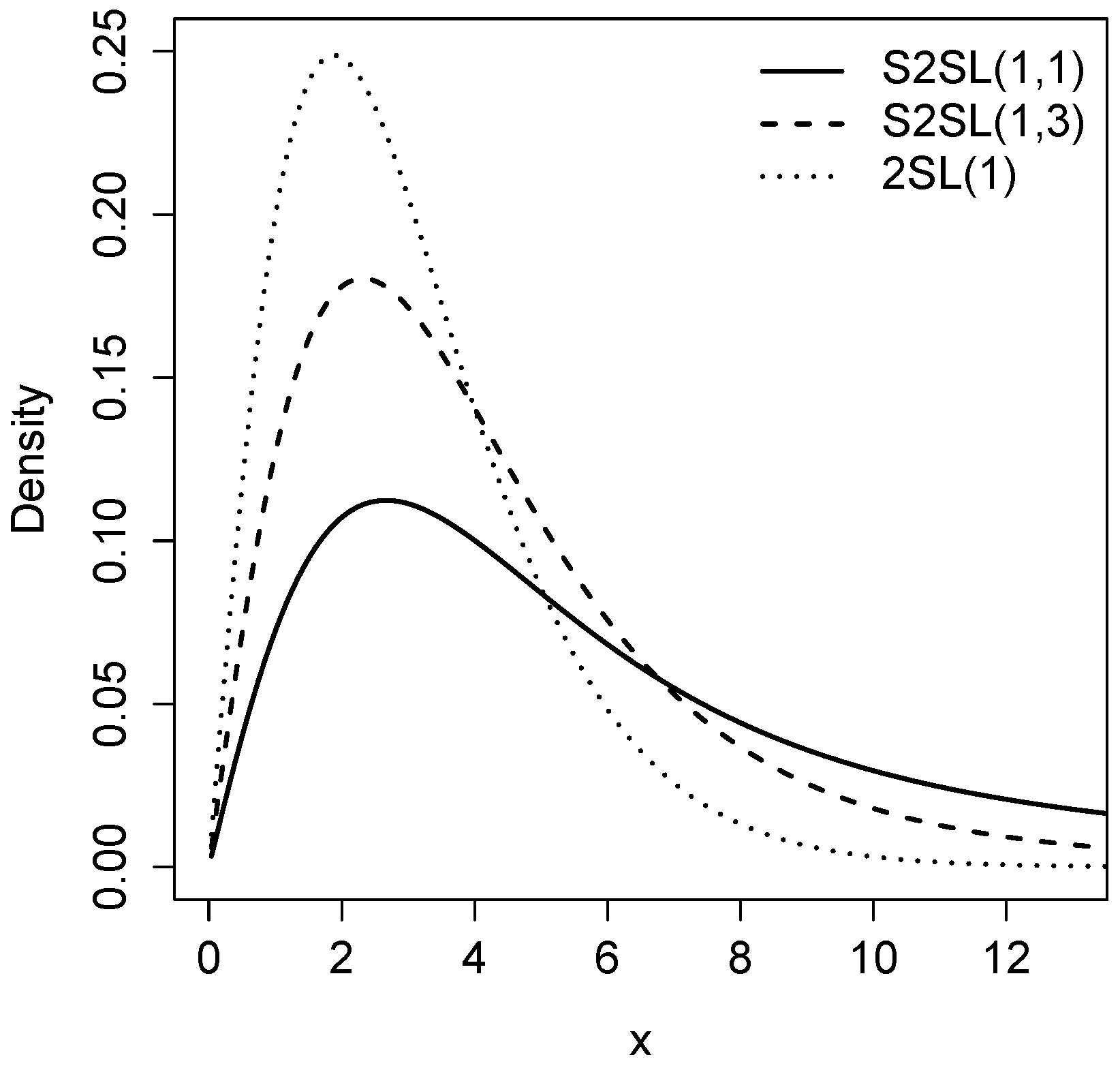
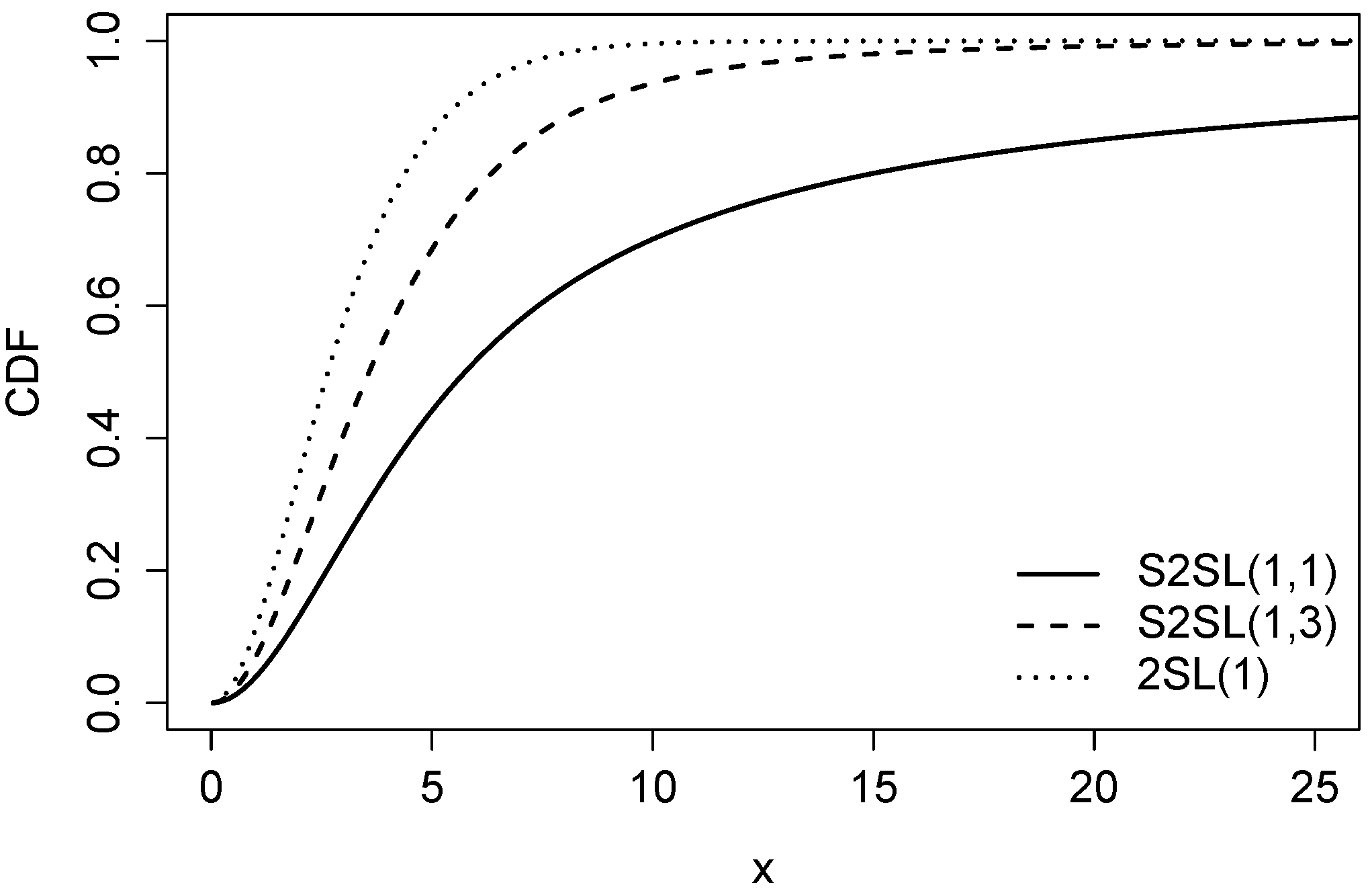

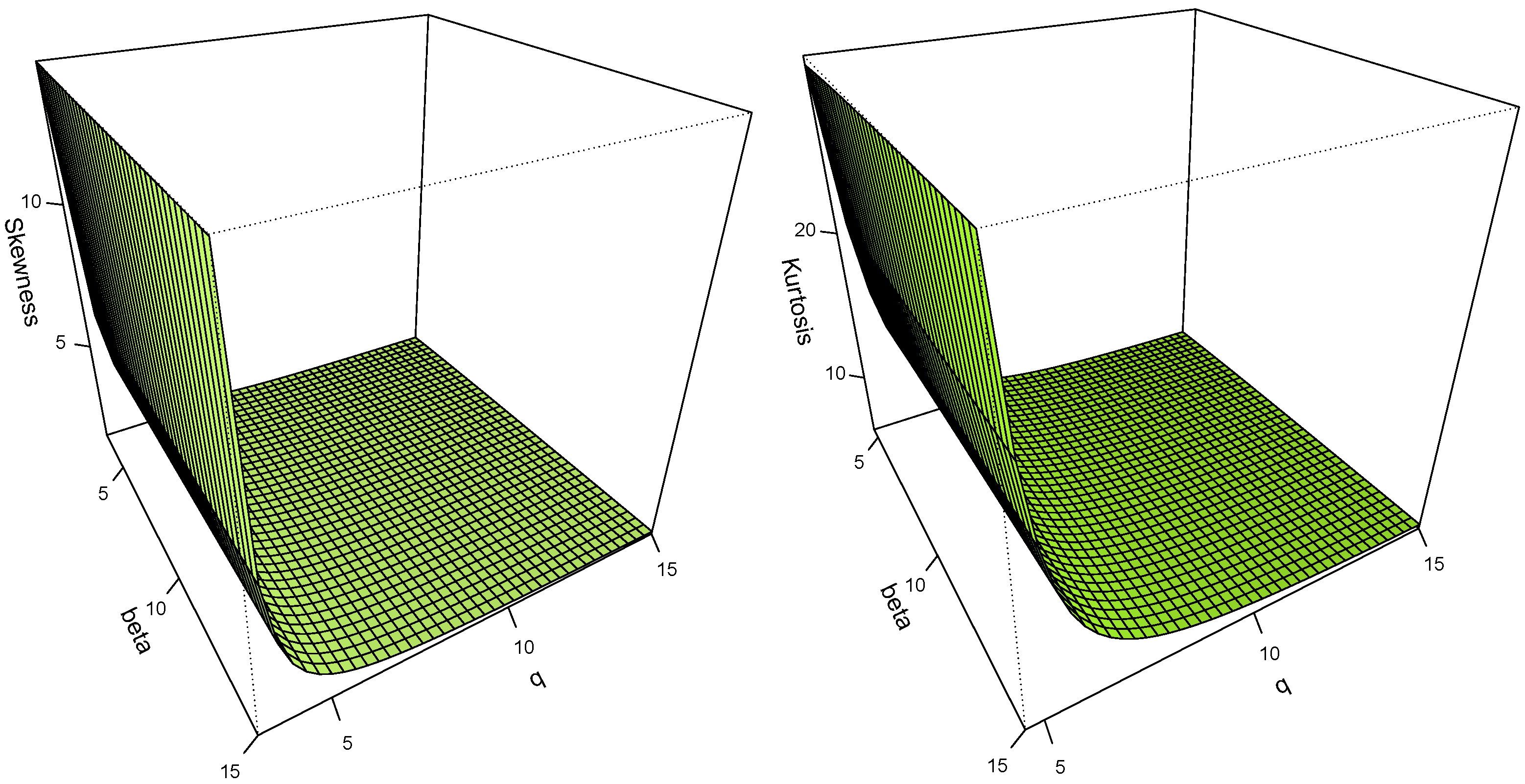

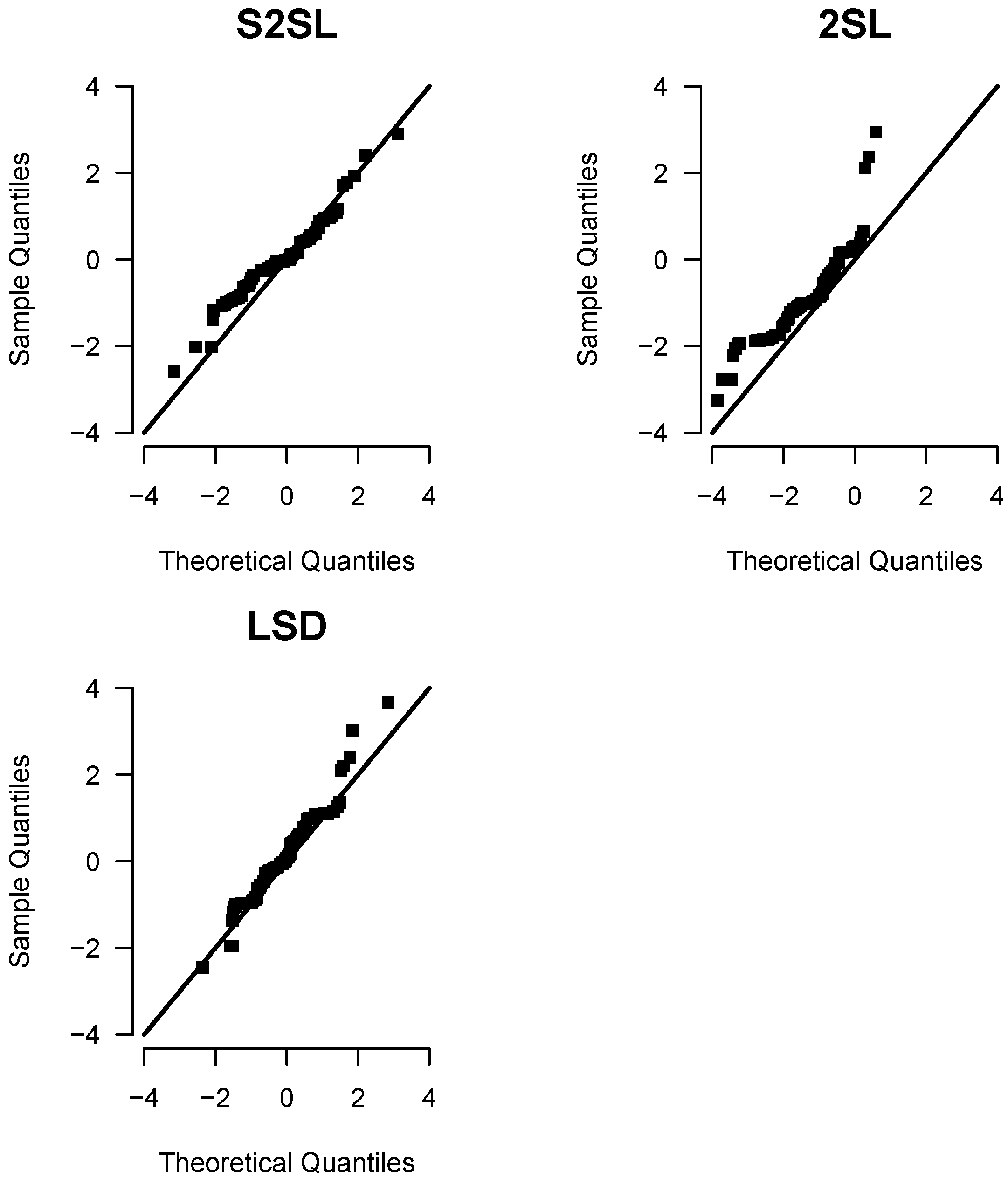
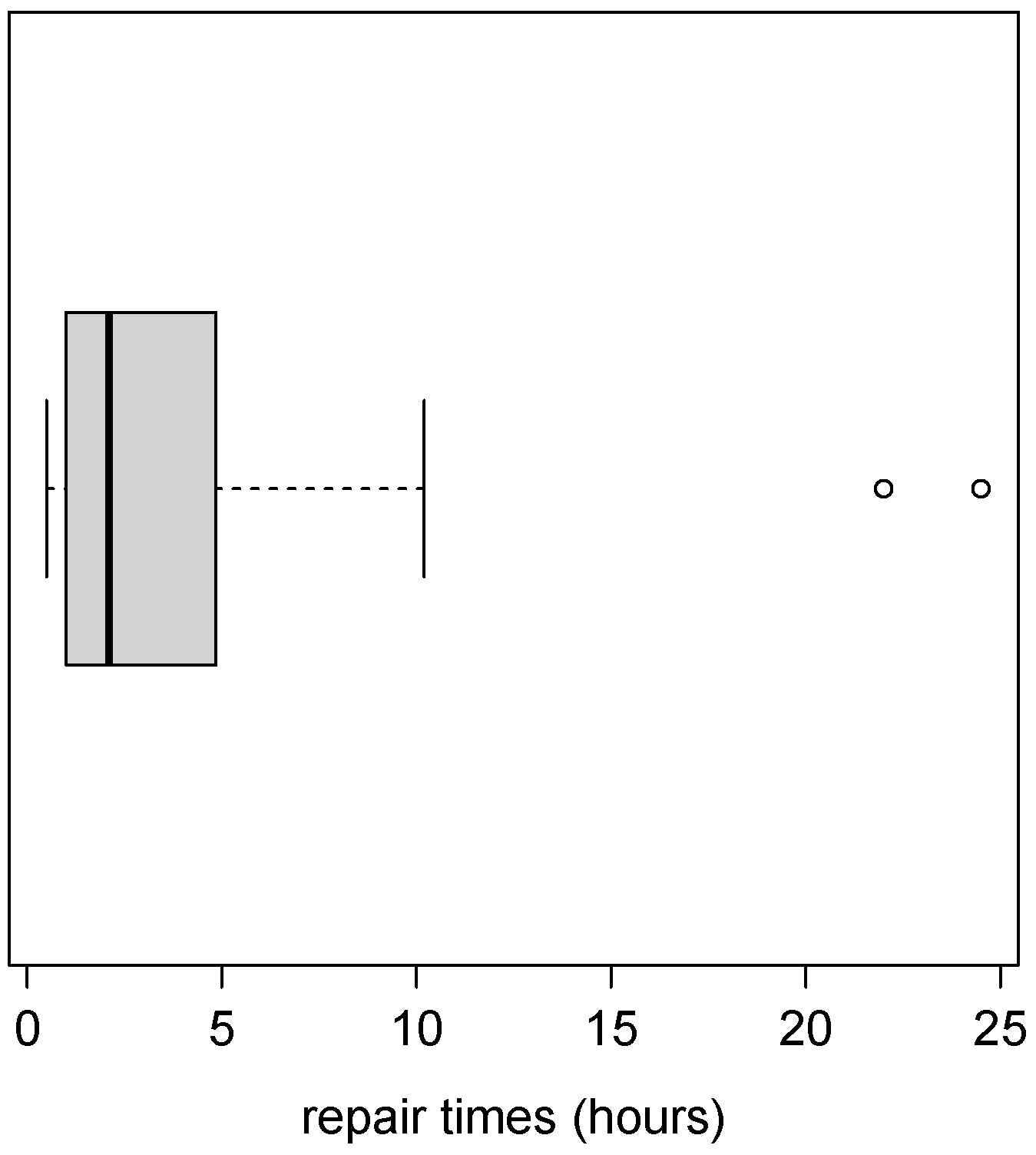
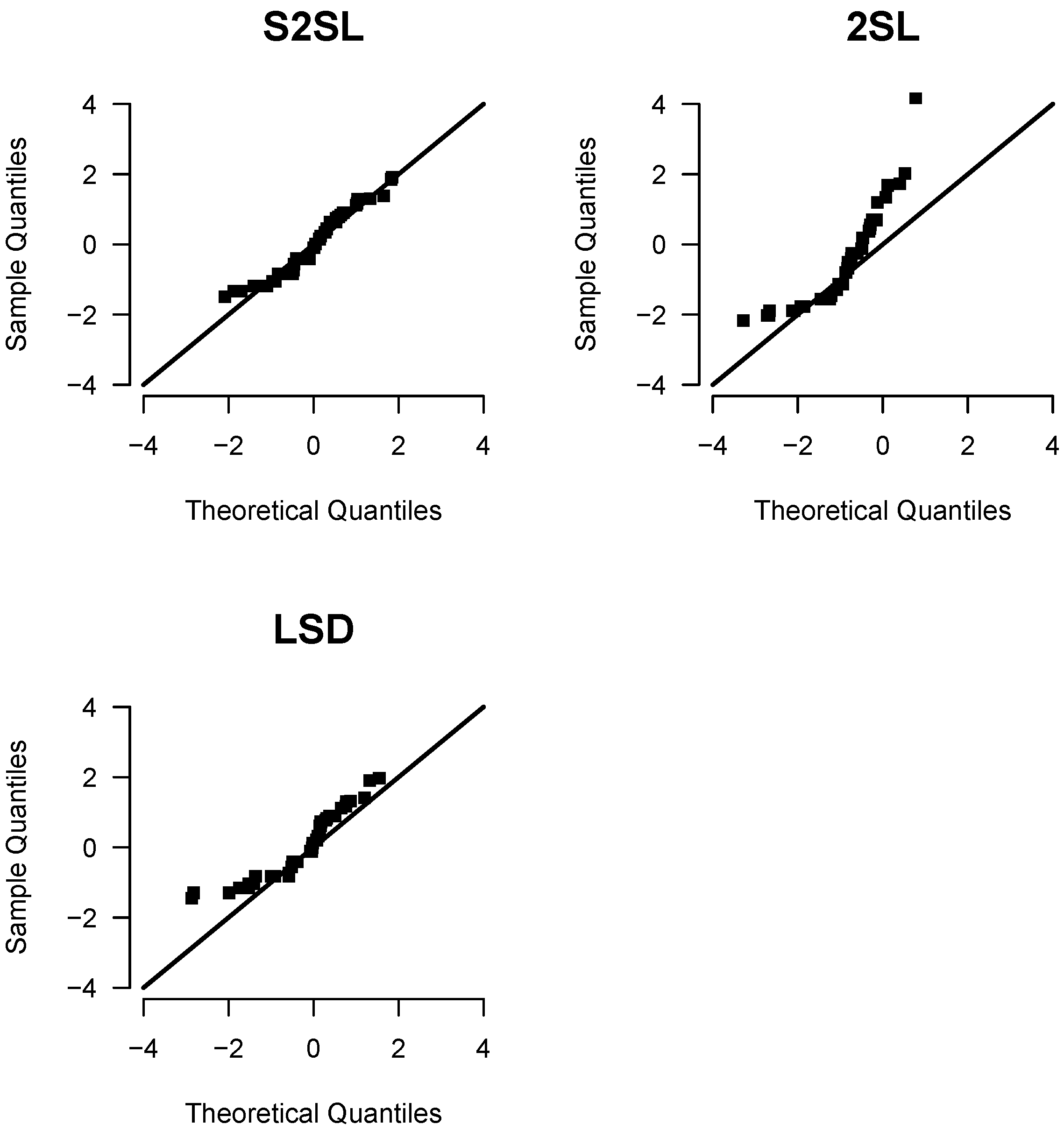
| Distribution | |||
|---|---|---|---|
| S2SL (1, 1) | 0.5586 | 0.2995 | 0.2000 |
| S2SL (1, 5) | 0.2428 | 0.0267 | 0.0041 |
| S2SL (1, 10) | 0.1876 | 0.0104 | 0.0005 |
| 2SL (1) | 0.1387 | 0.0041 | 0.0001 |
| True Value | ||||||||||||||||||
|---|---|---|---|---|---|---|---|---|---|---|---|---|---|---|---|---|---|---|
| Estim. | Mean | SE | RMSE | CP | Mean | SE | RMSE | CP | Mean | SE | RMSE | CP | Mean | SE | RMSE | CP | ||
| 2 | 0.5 | 2.022 | 0.410 | 0.403 | 0.939 | 2.020 | 0.288 | 0.288 | 0.949 | 2.004 | 0.201 | 0.207 | 0.94 | 2.013 | 0.128 | 0.125 | 0.951 | |
| 0.515 | 0.091 | 0.099 | 0.949 | 0.505 | 0.063 | 0.065 | 0.955 | 0.503 | 0.044 | 0.046 | 0.94 | 0.497 | 0.027 | 0.027 | 0.948 | |||
| 1 | 1.999 | 0.338 | 0.356 | 0.941 | 1.996 | 0.237 | 0.232 | 0.948 | 2.000 | 0.168 | 0.161 | 0.954 | 2.002 | 0.106 | 0.108 | 0.941 | ||
| 1.080 | 0.246 | 0.297 | 0.970 | 1.030 | 0.159 | 0.167 | 0.970 | 1.014 | 0.109 | 0.114 | 0.961 | 1.004 | 0.068 | 0.068 | 0.954 | |||
| 1.5 | 1.973 | 0.315 | 0.318 | 0.934 | 2.005 | 0.224 | 0.221 | 0.945 | 1.995 | 0.157 | 0.160 | 0.934 | 1.996 | 0.099 | 0.093 | 0.961 | ||
| 1.765 | 0.680 | 1.969 | 0.960 | 1.577 | 0.302 | 0.324 | 0.967 | 1.546 | 0.204 | 0.220 | 0.954 | 1.521 | 0.124 | 0.126 | 0.958 | |||
| 4 | 0.5 | 4.019 | 0.873 | 0.898 | 0.918 | 4.034 | 0.618 | 0.622 | 0.940 | 4.046 | 0.438 | 0.448 | 0.945 | 4.014 | 0.274 | 0.275 | 0.949 | |
| 0.519 | 0.094 | 0.101 | 0.945 | 0.504 | 0.063 | 0.065 | 0.951 | 0.499 | 0.044 | 0.045 | 0.946 | 0.498 | 0.028 | 0.028 | 0.947 | |||
| 1 | 3.958 | 0.725 | 0.758 | 0.916 | 3.997 | 0.514 | 0.501 | 0.953 | 4.026 | 0.366 | 0.379 | 0.939 | 4.008 | 0.230 | 0.224 | 0.960 | ||
| 1.103 | 0.270 | 0.375 | 0.968 | 1.043 | 0.165 | 0.180 | 0.961 | 1.012 | 0.111 | 0.119 | 0.937 | 1.004 | 0.069 | 0.068 | 0.953 | |||
| 1.5 | 3.966 | 0.691 | 0.714 | 0.932 | 4.019 | 0.487 | 0.506 | 0.929 | 4.000 | 0.341 | 0.349 | 0.937 | 3.996 | 0.215 | 0.222 | 0.936 | ||
| 1.948 | 1.009 | 4.297 | 0.962 | 1.583 | 0.318 | 0.361 | 0.963 | 1.546 | 0.210 | 0.218 | 0.959 | 1.515 | 0.128 | 0.137 | 0.945 | |||
| 6 | 0.5 | 6.078 | 1.375 | 1.410 | 0.921 | 6.054 | 0.965 | 1.008 | 0.938 | 6.015 | 0.676 | 0.695 | 0.941 | 6.002 | 0.425 | 0.426 | 0.955 | |
| 0.522 | 0.094 | 0.106 | 0.946 | 0.509 | 0.065 | 0.068 | 0.953 | 0.505 | 0.045 | 0.048 | 0.948 | 0.503 | 0.028 | 0.028 | 0.943 | |||
| 1 | 6.045 | 1.155 | 1.197 | 0.926 | 6.019 | 0.810 | 0.862 | 0.928 | 6.005 | 0.569 | 0.59 | 0.944 | 6.004 | 0.358 | 0.364 | 0.945 | ||
| 1.075 | 0.253 | 0.294 | 0.953 | 1.035 | 0.166 | 0.180 | 0.963 | 1.016 | 0.113 | 0.12 | 0.949 | 1.008 | 0.070 | 0.069 | 0.953 | |||
| 1.5 | 5.958 | 1.082 | 1.123 | 0.925 | 5.962 | 0.755 | 0.787 | 0.930 | 5.997 | 0.534 | 0.547 | 0.948 | 5.988 | 0.336 | 0.346 | 0.939 | ||
| 1.931 | 1.136 | 4.178 | 0.964 | 1.623 | 0.340 | 0.414 | 0.957 | 1.544 | 0.213 | 0.220 | 0.967 | 1.525 | 0.130 | 0.140 | 0.942 | |||
| n | s | |||
|---|---|---|---|---|
| 73 | 3.76 | 10.60 | 6.80 | 51.78 |
| Estimations | 2SL (SE) | LSD (SE) | S2SL (SE) |
|---|---|---|---|
| 0.8245 (0.0509) | - | 2.4243 (0.2969) | |
| - | 0.0343 (0.0371) | - | |
| - | 0.0233 (0.0258) | - | |
| - | 2.3092 (0.7187) | 1.4611 (0.2903) | |
| AIC | 468.1453 | 290.0614 | 282.5487 |
| BIC | 470.4357 | 296.9328 | 287.1296 |
| n | s | |||
|---|---|---|---|---|
| 40 | 4.01 | 5.17 | 1.85 | 10.02 |
| Estimations | 2SL (SE) | LSD (SE) | S2SL (SE) |
|---|---|---|---|
| 0.7787 (0.0647) | - | 2.0323 (0.4068) | |
| - | 0.0158 (0.0141) | - | |
| - | 0.0113 (0.0102) | - | |
| - | 1.3333 (0.4079) | 1.2423 (0.3462) | |
| AIC | 223.5754 | 189.9217 | 187.8777 |
| BIC | 225.2642 | 194.9884 | 191.2554 |
Disclaimer/Publisher’s Note: The statements, opinions and data contained in all publications are solely those of the individual author(s) and contributor(s) and not of MDPI and/or the editor(s). MDPI and/or the editor(s) disclaim responsibility for any injury to people or property resulting from any ideas, methods, instructions or products referred to in the content. |
© 2025 by the authors. Licensee MDPI, Basel, Switzerland. This article is an open access article distributed under the terms and conditions of the Creative Commons Attribution (CC BY) license (https://creativecommons.org/licenses/by/4.0/).
Share and Cite
Muñoz, H.A.; Castillo, J.S.; Gallardo, D.I.; Venegas, O.; Gómez, H.W. EM Algorithm in the Slash 2S-Lindley Distribution with Applications. Axioms 2025, 14, 101. https://doi.org/10.3390/axioms14020101
Muñoz HA, Castillo JS, Gallardo DI, Venegas O, Gómez HW. EM Algorithm in the Slash 2S-Lindley Distribution with Applications. Axioms. 2025; 14(2):101. https://doi.org/10.3390/axioms14020101
Chicago/Turabian StyleMuñoz, Héctor A., Jaime S. Castillo, Diego I. Gallardo, Osvaldo Venegas, and Héctor W. Gómez. 2025. "EM Algorithm in the Slash 2S-Lindley Distribution with Applications" Axioms 14, no. 2: 101. https://doi.org/10.3390/axioms14020101
APA StyleMuñoz, H. A., Castillo, J. S., Gallardo, D. I., Venegas, O., & Gómez, H. W. (2025). EM Algorithm in the Slash 2S-Lindley Distribution with Applications. Axioms, 14(2), 101. https://doi.org/10.3390/axioms14020101








